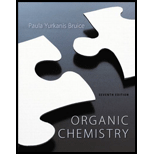
Concept explainers
(a)
Interpretation:
From the given species better nucleophile in the given solvent has to be identified.
Concept Introduction:
- Aprotic solvent are polar solvent molecules which do not have hydrogen bonded to oxygen to nitrogen.
- Protic solvent are polar solvent molecules which do have hydrogen bonded to oxygen to nitrogen.
- The stronger base is always a better nucleophile in an aprotic solvent.
(b)
Interpretation:
From the given species better nucleophile in the given solvent has to be identified.
Concept Introduction:
- Aprotic solvent are polar solvent molecules which do not have hydrogen bonded to oxygen to nitrogen.
- Protic solvent are polar solvent molecules which do have hydrogen bonded to oxygen to nitrogen.
- The stronger base is always a better nucleophile in an aprotic solvent.
(c)
Interpretation:
From the given species better nucleophile in the given solvent has to be identified.
Concept Introduction:
- Aprotic solvent are polar solvent molecules which do not have hydrogen bonded to oxygen to nitrogen.
- Protic solvent are polar solvent molecules which do have hydrogen bonded to oxygen to nitrogen
- The stronger base is always a better nucleophile in an aprotic solvent.
(d)
Interpretation:
From the given species better nucleophile in the given solvent has to be identified.
Concept Introduction:
- Aprotic solvent are polar solvent molecules which do not have hydrogen bonded to oxygen to nitrogen.
- Protic solvent are polar solvent molecules which do have hydrogen bonded to oxygen to nitrogen
- The stronger base is always a better nucleophile in an aprotic solvent.
(e)
Interpretation:
From the given species better nucleophile in the given solvent has to be identified.
Concept Introduction:
- Aprotic solvent are polar solvent molecules which do not have hydrogen bonded to oxygen to nitrogen.
- Protic solvent are polar solvent molecules which do have hydrogen bonded to oxygen to nitrogen
- The stronger base is always a better nucleophile in an aprotic solvent.
(f)
Interpretation:
From the given species better nucleophile in the given solvent has to be identified.
Concept Introduction:
- Aprotic solvent are polar solvent molecules which do not have hydrogen bonded to oxygen to nitrogen.
- Protic solvent are polar solvent molecules which do have hydrogen bonded to oxygen to nitrogen
- The stronger base is always a better nucleophile in an aprotic solvent.
(g)
Interpretation:
From the given species better nucleophile in the given solvent has to be identified.
Concept Introduction:
- Aprotic solvent are polar solvent molecules which do not have hydrogen bonded to oxygen to nitrogen.
- Protic solvent are polar solvent molecules which do have hydrogen bonded to oxygen to nitrogen
- The stronger base is always a better nucleophile in an aprotic solvent.
(h)
Interpretation:
From the given species better nucleophile in the given solvent has to be identified.
Concept Introduction:
- Aprotic solvent are polar solvent molecules which do not have hydrogen bonded to oxygen to nitrogen.
- Protic solvent are polar solvent molecules which do have hydrogen bonded to oxygen to nitrogen
- The stronger base is always a better nucleophile in an aprotic solvent.
Want to see the full answer?
Check out a sample textbook solution
Chapter 9 Solutions
Organic Chemistry; Modified MasteringChemistry with Pearson eText -- ValuePack Access Card; Study Guide and Student Solutions Manual for Organic Chemistry, Books a la Carte Edition (7th Edition)
- At 90ºC the vapor pressure of ortho-xylene is 20 kPa and that of meta-xylene is 18 kPa. What is the composition of the vapor in equilibrium with a mixture in which the mole fraction of o-xylene is 0.60?arrow_forwardDraw the products of this reduction of a ketone with sodium borohydride. Use a dash or wedge bond to indicate the stereochemistry of substituents on asymmetric centers, where applicableIgnore any inorganic byproducts. 1) NaBH4 2) HCI/H2O Select to Drawarrow_forwardWhy do you think people who live at high altitudes are advised to add salt to water when boiling food like pasta? What mole fraction of NaCl is needed to raise the boiling point of H2O by 3˚C? Does the amount of salt added to water (typically about one teaspoon to four quarts of water) substantially change the boiling point? (Kb (H2O) = 0.51˚C/molal.)arrow_forward
- pls help asaparrow_forwardpls help asaparrow_forward9. Consider the following galvanic cell: Fe (s) | Fe(NO3)2 (aq) || Sn(NO3)2 (aq) | Sn (s) a. Write an equation for the half reactions occurring at the anode and cathode. b. Calculate the standard cell potential Show all of your work. c. Draw and label the galvanic cell, including the anode and cathode, direction of electron flow, and direction of ion migration.arrow_forward
- pls help asaparrow_forward11. Use the equation below to answer the following questions: 2 Al(s) + 3 Cd(NO3)2 (aq) → 2 Al(NO3)3 (aq) + 3 Cd(s) a. What is the net ionic equation for the reaction? b. Which species is a spectator ion in this reaction? Define a spectator ion. c. Identify the oxidizing agent and the reducing agent.arrow_forwardpls help asaparrow_forward
 Organic Chemistry: A Guided InquiryChemistryISBN:9780618974122Author:Andrei StraumanisPublisher:Cengage Learning
Organic Chemistry: A Guided InquiryChemistryISBN:9780618974122Author:Andrei StraumanisPublisher:Cengage Learning EBK A SMALL SCALE APPROACH TO ORGANIC LChemistryISBN:9781305446021Author:LampmanPublisher:CENGAGE LEARNING - CONSIGNMENT
EBK A SMALL SCALE APPROACH TO ORGANIC LChemistryISBN:9781305446021Author:LampmanPublisher:CENGAGE LEARNING - CONSIGNMENT

